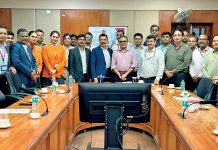Environmental concerns and sustainability become vital in warehousing and logistics sector. Adoption of eco-friendly practices will not only boost the growth of the sector but also attract continued investment, says Arif A Siddiqui, VP, Warehousing Association of India & Founder and Director, Coign Consulting.
CT Bureau
What is your vision for the warehousing and logistics sector?
Continued investments in modern warehouses, cold storage facilities, and transportation networks will be crucial. This will involve public and private sector participation to enhance efficiency and connectivity across India. The integration of technologies such as Internet of Things, Artificial Intelligence, automation, and data analytics will optimise warehouse operations, improve inventory management, and enhance overall supply chain visibility and efficiency.
With the increasing demand for faster and reliable delivery services, there will be a focus on developing last-mile delivery (LMD) solutions, including alternative delivery methods such as drones and autonomous vehicles.
Environmental concerns and sustainability will become paramount in the warehousing and logistics sector. Adoption of eco-friendly practices such as green buildings, electric vehicles, and efficient energy management will be encouraged. Efforts in regulatory reforms, including simplification of tax system, state logistics policies, faster clearance, approval procedures, and streamlining of transportation regulations, will boost the sector’s growth and attract more investment. Strengthening ties with global markets and integrating into global supply chains will open new prospects for Indian warehousing and logistics companies.
Overall, the warehousing and logistics sectors are poised for continued growth in the coming years, driven by factors such as technological advancements, infrastructure development, and favourable government policies, among others. However, addressing challenges such as infrastructure bottlenecks, regulatory hurdles, and skill shortages and the like will be crucial to realising the sector’s full potential.
What is crucial to succeed in the coming years?
Industry advocacy and representation: It is crucial to advocate for the interests of the warehousing and logistics sector, representing members’ concerns, and influencing policy decisions at the national and state levels. Building relationships with government agencies, policymakers, and stakeholders will be essential to drive regulatory reforms and address sector-specific challenges.
Skills development and talent management: Investing in skills development programmes and talent management initiatives will address the shortage of skilled manpower in the industry. Providing training opportunities, certifications, and career advancement pathways can attract and retain talent, while ensuring a skilled workforce capable of meeting evolving industry demands.
Share with us the WAI’s upcoming projects and growth strategies?
Conducting research studies to gather insights into industry trends, challenges, and opportunities can provide valuable data to members and guide strategic decision-making. This could include market analysis, technology trends, regulatory updates, and best practices in warehousing and logistics. Organising training workshops, seminars, and certification programmes to enhance and update skills and knowledge of professionals in the sector. The topics could range from supply chain management and logistics operations to safety, security, and sustainability practices. Collaborating with technology providers to offer member discounts or incentives for implementing innovative solutions such as WMS, IoT devices, and automation technologies.
Engaging with government agencies, policymakers, and regulatory bodies to advocate for policies and regulations that promote the growth and development of the warehousing sector. Hosting networking events, conferences, and trade shows to bring together stakeholders, thought leaders, and experts for knowledge exchange, business networking, and collaboration opportunities. Exploring opportunities for international partnerships and collaborations to facilitate global trade, technology transfer, and market expansion.
What are the current challenges? Can you suggest some solutions?
Infrastructural bottlenecks, including roads, ports, and warehouses, lead to congestion, delays, and rise in transportation costs. The solution is to increase investments in infrastructure development projects such as road and rail networks, ports, and modern warehouses. PPPs can be leveraged to expedite infrastructure projects. Poor last-mile connectivity in urban and rural areas hampers timely delivery and increases transportation costs.
Improving it through initiatives such as building more distribution centres, implementing alternative delivery methods such as EVs, and leveraging technology for route optimisation. Cargo theft, tampering, and security breaches pose risks to warehousing and logistics operations. Enhance security measures through the implementation of access controls, CCTV surveillance, alarm systems, and security audits. Collaborate with law enforcement agencies and private security providers to mitigate security risks. Concerns such as pollution, carbon emissions, and waste generation must be addressed in operations of warehousing and logistics sectors.
Promoting eco-friendly practices such as green building designs, energy-efficient technologies, electric and hybrid vehicles, and sustainable packaging materials. Implementing waste management and recycling programmes to reduce environmental impact. Addressing these issues requires a concerted effort from the government, industry stakeholders, and technology providers. By implementing the said solutions, the warehousing and logistics sectors can overcome hurdles and achieve sustainable growth and efficiency.













